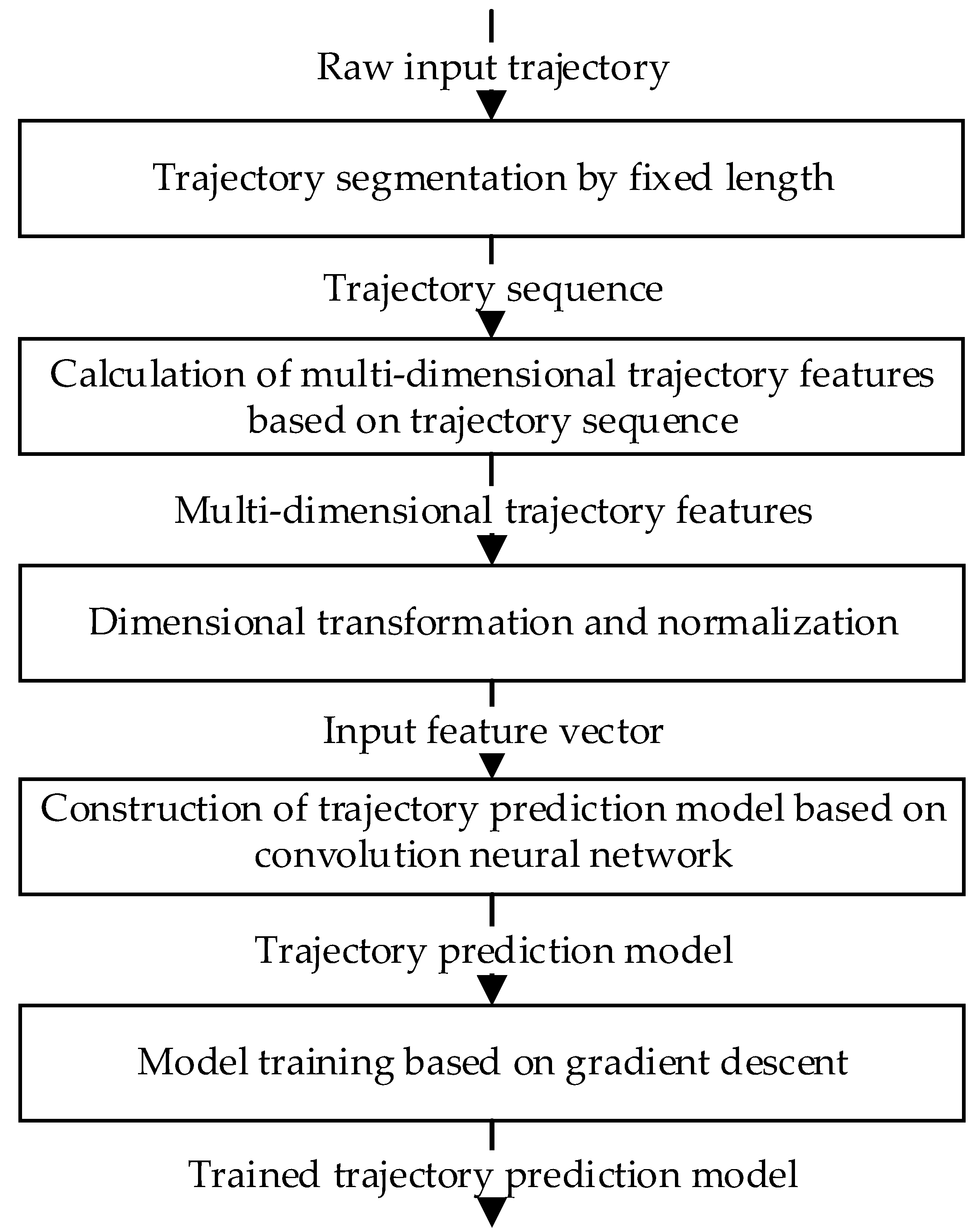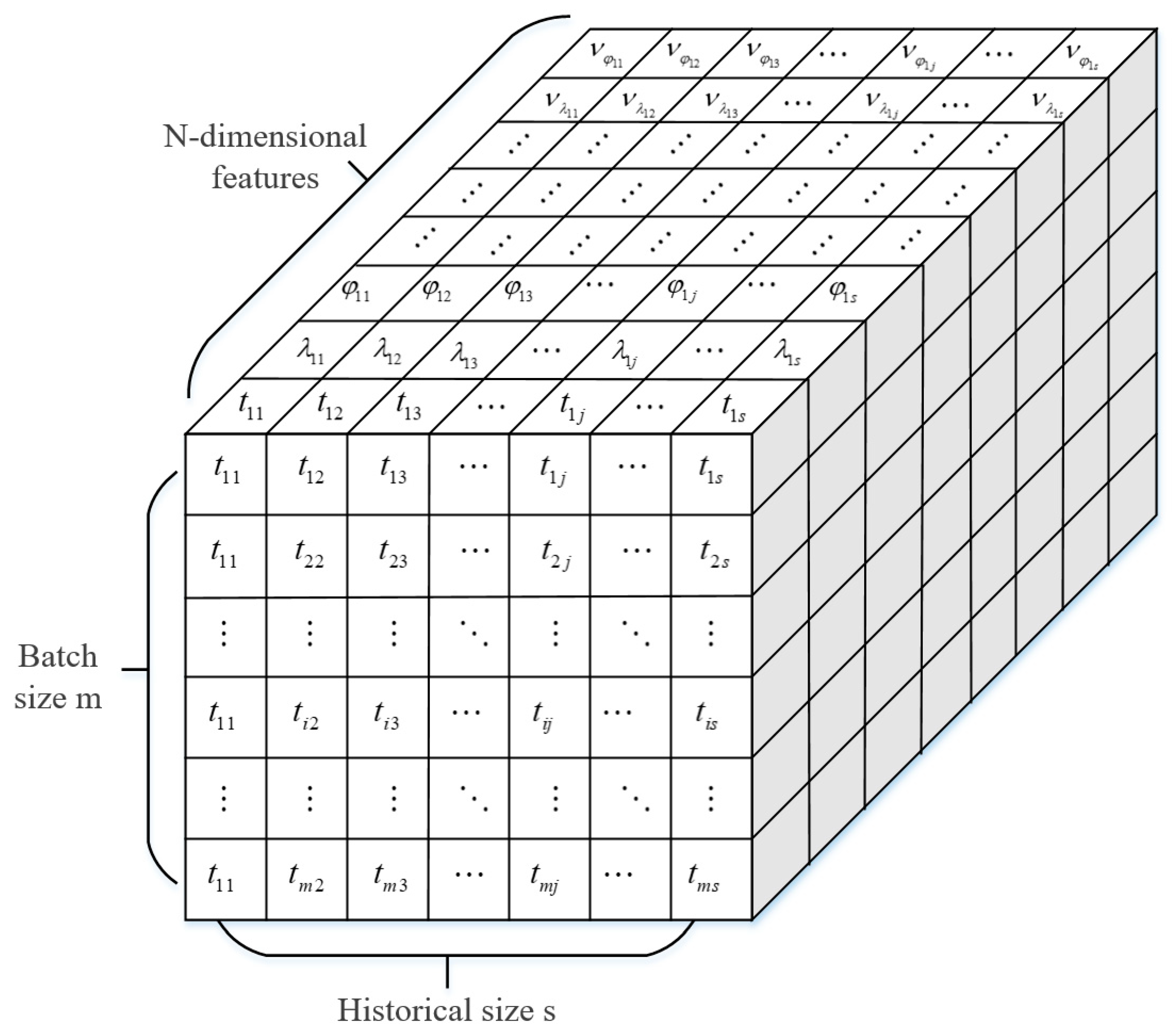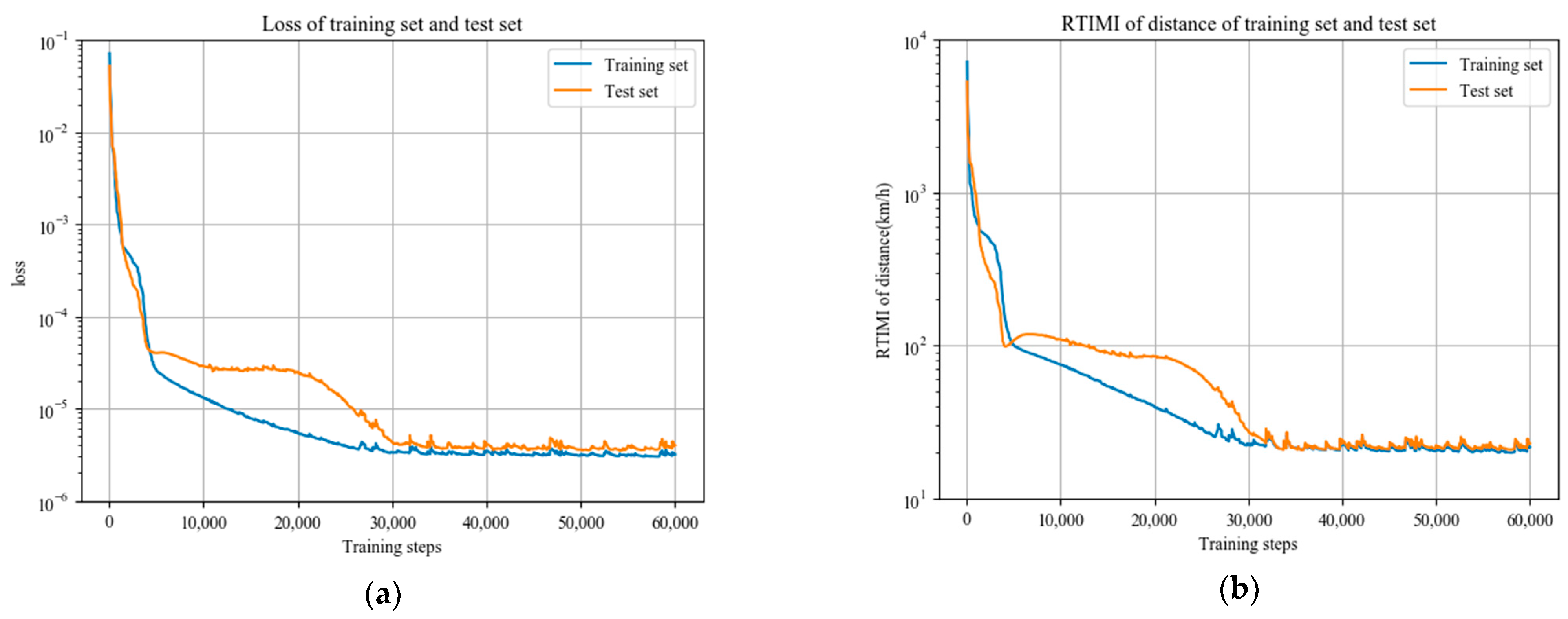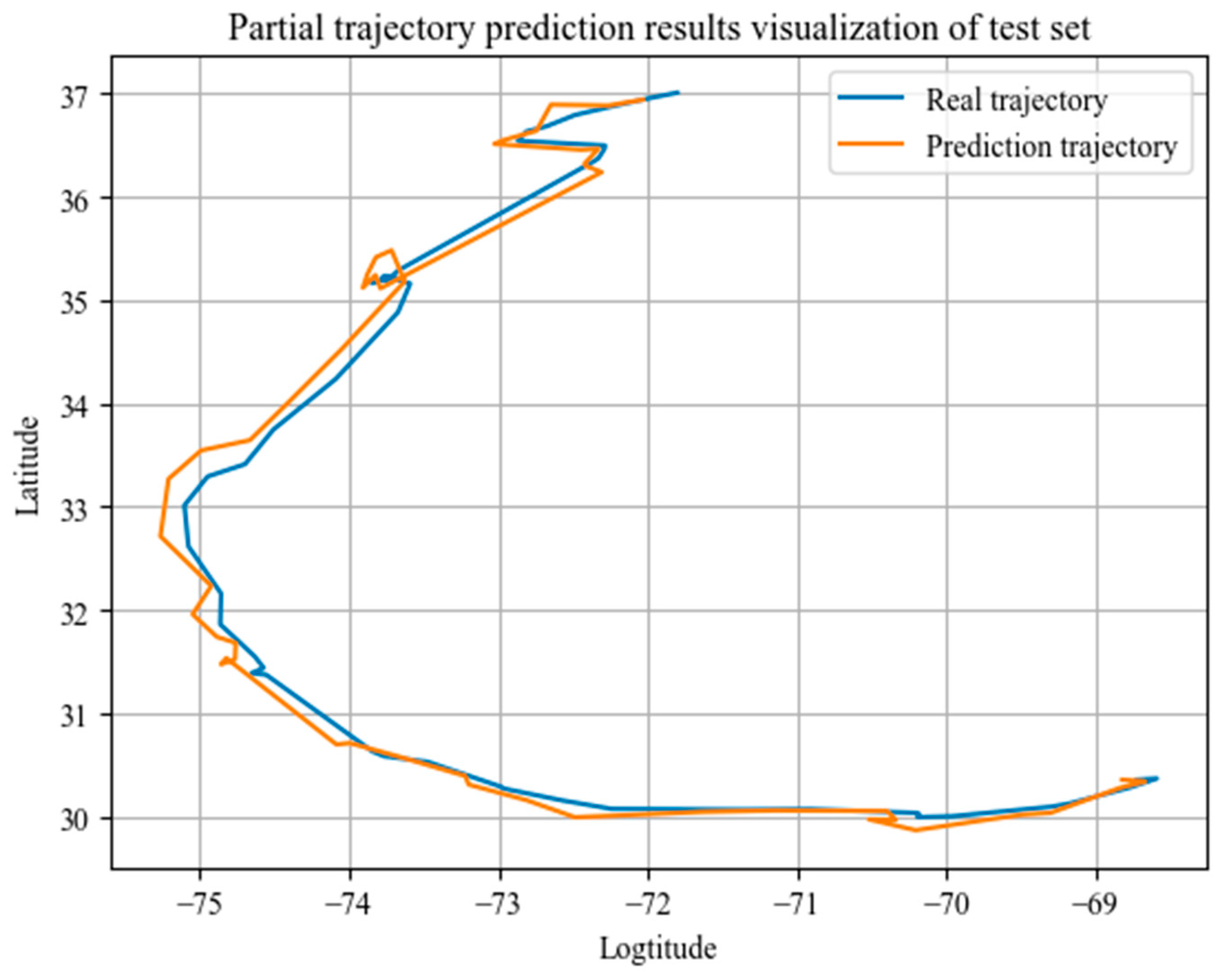Trajectory Prediction of Marine Moving Target Using Deep Neural Networks with Trajectory Data
Abstract
1. Introduction
- We study the problem of trajectory prediction with sparse non-uniform time series data. Our work differs from previous works in that our method can process such a task without an interpolation algorithm for uniform sampling and is adaptive to long-term and variable time interval prediction requirements.
- We innovatively employ the CNN model to the trajectory prediction problem with inspiration from the idea of local correlation perception and weight sharing. To the best of our knowledge, this is the first study in which local connection characteristics of the CNN have been applied to the time domain to solve ship trajectory prediction problems.
- When applied to the satellite-based search of marine mobile targets, track prediction can reduce target location uncertainty and guide satellite-based search tasks, thus improving target search efficiency.
2. Related Studies
2.1. Convolutional Neural Network
2.2. Ship Trajectory Prediction
3. Materials and Methods
3.1. Multi-Dimensional Trajectory Features
- (1)
- The spatial–temporal information of the current state:
- (2)
- The spatial–temporal change information of the current state relative to the initial state:
- (3)
- The spatial–temporal change information of the current state relative to the previous state:
- (4)
- The average velocity information of the current state relative to the initial state:
- (5)
- The average velocity information of the current state relative to the previous state:
- (6)
- The acceleration information describing the change of velocity:
3.2. Network Architecture
3.3. Network Training Method
4. Experiments
4.1. Experimental Conditions
4.2. Experimental Results
4.3. Comparisons with Other Algorithms
5. Discussion
6. Conclusions
7. Limitation of the Study
8. Future Recommendations
Author Contributions
Funding
Institutional Review Board Statement
Informed Consent Statement
Data Availability Statement
Conflicts of Interest
References
- Ci, Y.Z.; He, R.J.; Xu, Y.F.; Tan, Y.J. Method of target motion prediction for moving target search by satellite. Control. Decis. 2009, 24, 1007–1012. [Google Scholar]
- Chen, C.-C.; Chiang, M.-F.; Peng, W.-C. Mining and clustering mobility evolution patterns from social media for urban informatics. Knowl. Inf. Syst. 2015, 47, 381–403. [Google Scholar] [CrossRef]
- Zhang, C.; Han, J.; Shou, L.; Lu, J.; La Porta, T. Splitter: Mining fine-grained sequential patterns in semantic trajectories. Proc. VLDB Endow. 2014, 7, 769–780. [Google Scholar] [CrossRef]
- Zheng, Y. Trajectory data mining: An overview. ACM Trans. Intell. Syst. Technol. 2015, 6, 1–41. [Google Scholar] [CrossRef]
- Yao, D.; Zhang, C.; Zhu, Z.; Huang, J.; Bi, J. Trajectory Clustering via Deep Representation Learning. In Proceedings of the 2017 International Joint Conference on Neural Networks (IJCNN), Anchorage, AL, USA, 14–19 May 2017; pp. 3880–3887. [Google Scholar]
- Zhang, J.; Shi, H.; Cui, L. Location prediction model based on transportation mode and semantic trajectory. J. Comput. Res. Dev. 2019, 56, 1357–1369. [Google Scholar]
- Xie, G.; Shangguan, A.; Fei, R.; Ji, W.; Ma, W.; Hei, X. Motion trajectory prediction based on a CNN-LSTM sequential model. Sci. China Inf. Sci. 2020, 63, 1–21. [Google Scholar] [CrossRef]
- Tang, H.; Yin, Y.; Shen, H. A model for vessel trajectory prediction based on long short-term memory neural network. J. Mar. Eng. Technol. 2019, 21, 136–145. [Google Scholar] [CrossRef]
- Xu, Y.F.; Tan, Y.J.; He, R.J.; Ci, Y.Z. Multi-model Prediction for Maritime Moving Target Motion. Huoli Yu Zhihui Kongzhi 2012, 37, 20–25. [Google Scholar]
- Capobianco, S.; Millefiori, L.M.; Forti, N.; Braca, P.; Willett, P. Deep Learning Methods for Vessel Trajectory Prediction Based on Recurrent Neural Networks. IEEE Trans. Aerosp. Electron. Syst. 2021, 57, 4329–4346. [Google Scholar] [CrossRef]
- Li, M.; Lv, B.; Dong, W.; Wang, D. Model of multi-Sensor Data Fusion and Trajectory Prediction Based on Echo State Network. In Proceedings of the 2010 International Conference on Computer, Mechatronics, Control and Electronic Engineering, Changchun, China, 24–26 August 2010; pp. 338–341. [Google Scholar]
- Bogaerts, T.; Masegosa, A.D.; Angarita-Zapata, J.S.; Onieva, E.; Hellinckx, P. A graph CNN-LSTM neural network for short and long-term traffic forecasting based on trajectory data. Transp. Res. Part C Emerg. Technol. 2020, 112, 62–77. [Google Scholar] [CrossRef]
- Neto, J.B.P.; Mitton, N.; Campista, M.E.M.; Costa, L.H.M. Dead reckoning using time series regression models. In Proceedings of the 4th ACM MobiHoc Workshop on Experiences with the Design and Implementation of Smart Objects, Los Angeles, CA, USA, 25 June 2018; pp. 1–6. [Google Scholar]
- Rong, H.; Teixeira, A.; Soares, C.G. Ship trajectory uncertainty prediction based on a Gaussian Process model. Ocean Eng. 2019, 182, 499–511. [Google Scholar] [CrossRef]
- Liu, J.; Shi, G.; Zhu, K. Vessel Trajectory Prediction Model Based on AIS Sensor Data and Adaptive Chaos Differential Evolution Support Vector Regression (ACDE-SVR). Appl. Sci. 2019, 9, 2983. [Google Scholar] [CrossRef]
- Zhou, H.; Chen, Y.; Zhang, S. Ship Trajectory Prediction Based on BP Neural Network. J. Artif. Intell. 2019, 1, 29–36. [Google Scholar] [CrossRef]
- Zou, J.; Chen, S.; Cheng, Z.; Liao, J. Research on Collision Avoidance of Navigation Marks Based on Neural Network. In Proceedings of the 2020 7th International Forum on Electrical Engineering and Automation (IFEEA), Hefei, China, 25–27 September 2020; pp. 632–635. [Google Scholar]
- Suo, Y.; Chen, W.; Claramunt, C.; Yang, S. A Ship Trajectory Prediction Framework Based on a Recurrent Neural Network. Sensors 2020, 20, 5133. [Google Scholar] [CrossRef]
- Park, J.; Jeong, J.; Park, Y. Ship Trajectory Prediction Based on Bi-LSTM Using Spectral-Clustered AIS Data. J. Mar. Sci. Eng. 2021, 9, 1037. [Google Scholar] [CrossRef]
- Gao, D.-W.; Zhu, Y.-S.; Zhang, J.-F.; He, Y.-K.; Yan, K.; Yan, B.-R. A novel MP-LSTM method for ship trajectory prediction based on AIS data. Ocean Eng. 2021, 228, 108956. [Google Scholar] [CrossRef]
- Zhao, J.; Lu, J.; Chen, X.; Yan, Z.; Yan, Y.; Sun, Y. High-fidelity data supported ship trajectory prediction via an ensemble machine learning framework. Phys. A Stat. Mech. Appl. 2021, 586, 126470. [Google Scholar] [CrossRef]
- Elnagar, A.; Gupta, K. Motion prediction of moving objects based on autoregressive model. IEEE Trans. Syst. Man Cybern. 1998, 28, 803–810. [Google Scholar] [CrossRef]
- LeCun, Y.; Bengio, Y.; Hinton, G. Deep learning. Nature 2015, 521, 436–444. [Google Scholar] [CrossRef]
- Zhang, Q.; Yang, L.T.; Chen, Z. Deep computation model for unsupervised feature learning on big data. IEEE Trans. Serv. Comput. 2015, 9, 161–171. [Google Scholar] [CrossRef]
- Cordts, M.; Omran, M.; Ramos, S.; Rehfeld, T.; Enzweiler, M.; Benenson, R.; Franke, U.; Roth, S.; Schiele, B. The cityscapes dataset for semantic urban scene understanding. In Proceedings of the IEEE Conference on Computer Vision and Pattern Recognition, Las Vegas, NV, USA, 27–30 June 2016; pp. 3213–3223. [Google Scholar]
- Silver, D.; Huang, A.; Maddison, C.J.; Guez, A.; Sifre, L.; van den Driessche, G.; Schrittwieser, J.; Antonoglou, I.; Panneershelvam, V.; Lanctot, M.; et al. Mastering the game of Go with deep neural networks and tree search. Nature 2016, 529, 484–489. [Google Scholar] [CrossRef] [PubMed]
- Litjens, G.; Kooi, T.; Bejnordi, B.E.; Setio, A.A.A.; Ciompi, F.; Ghafoorian, M.; van der Laak, J.A.; Van Ginneken, B.; Sánchez, C.I. A survey on deep learning in medical image analysis. Med. Image Anal. 2017, 42, 60–88. [Google Scholar] [CrossRef] [PubMed]
- Lecun, Y.; Bottou, L.; Bengio, Y.; Haffner, P. Gradient-based learning applied to document recognition. Proc. IEEE 1998, 86, 2278–2324. [Google Scholar] [CrossRef]
- Jeong, H.; Park, S.; Woo, S.; Lee, S. Rotating Machinery Diagnostics Using Deep Learning on Orbit Plot Images. Procedia Manuf. 2016, 5, 1107–1118. [Google Scholar] [CrossRef]
- Simonyan, K.; Zisserman, A. Very deep convolutional networks for large-scale image recognition. arXiv 2014, arXiv:1409.1556. [Google Scholar]
- Abadi, M.; Barham, P.; Chen, J.; Chen, Z.; Davis, A.; Dean, J.; Devin, M.; Ghemawat, S.; Irving, G.; Isard, M. {TensorFlow}: A system for {Large-Scale} machine learning. In Proceedings of the 12th USENIX Symposium on Operating Systems Design and Implementation (OSDI 16), Savannah, GA, USA, 2–4 November 2016; pp. 265–283. [Google Scholar]






| Training Steps | Loss of Training Set | Loss of Test Set |
|---|---|---|
| 1 | 0.239351 | 0.217599 |
| 2000 | 4.55702 × 10−4 | 2.79363 × 10−4 |
| 4000 | 3.19982 × 10−5 | 3.81833 × 10−5 |
| 6000 | 2.06495 × 10−5 | 3.98102 × 10−5 |
| 8000 | 1.58536 × 10−5 | 3.26941 × 10−5 |
| 10,000 | 1.25557 × 10−5 | 2.85061 × 10−5 |
| 20,000 | 5.28681 × 10−6 | 2.37062 × 10−5 |
| 30,000 | 3.27563 × 10−6 | 4.25452 × 10−6 |
| 40,000 | 3.11066 × 10−6 | 3.63867 × 10−6 |
| 50,000 | 3.06778 × 10−6 | 4.76017 × 10−6 |
| 60,000 | 3.14196 × 10−6 | 3.81424 × 10−6 |
| Number | Prediction Duration (h) | Longitude Error (Degree) | Latitude Error (Degree) | Distance Error (km) |
|---|---|---|---|---|
| 1 | 0.305 | −0.08594 | −0.00915 | 9.06339 |
| 2 | 0.677 | −0.193 | −0.269 | 36.207 |
| 3 | 0.854 | −0.071 | −0.118 | 15.112 |
| 4 | 1.202 | −0.221 | −0.244 | 35.721 |
| 5 | 1.362 | −0.191 | −0.042 | 20.232 |
| 6 | 1.812 | 0.102 | 0.006 | 10.439 |
| 7 | 2.1125 | 0.0965 | −0.3264 | 37.6564 |
| 8 | 2.113 | 0.0222491 | −0.36991 | 41.1962 |
| 9 | 2.145 | 0.213 | 0.027 | 22.082 |
| 10 | 2.17278 | 0.259359 | −0.30726 | 43.6366 |
| 11 | 2.21944 | 0.33176 | −0.38704 | 55.324 |
| 12 | 3.664 | −0.202414 | −0.12418 | 25.3107 |
| 13 | 3.79528 | −0.321965 | −0.53514 | 68.1318 |
| 14 | 3.90556 | −0.0867181 | −0.428768 | 48.5071 |
| 15 | 5.866 | −0.2643 | −0.403 | 52.395 |
| …… | …… | …… | …… | …… |
| RTIME | 0.157 | 0.118 | 20.610 |
| Algorithm | (Degree/h) | (Degree/h) | (km/h) |
|---|---|---|---|
| interpolation extrapolation [11] | 3.2547 | 3.7510 | 340.0171 |
| fitting extrapolation | 0.2777 | 0.2139 | 36.4040 |
| grey prediction [9] | 0.2625 | 0.2084 | 25.1501 |
| autoregressive prediction [22] | 0.2744 | 0.2615 | 41.98 |
| BP neural network [16] | 0.305 | 0.127 | 32.513 |
| LSTM neural network [8] | 1.018 | 0.536 | 119.306 |
| the algorithm presented in this paper | 0.157 | 0.118 | 20.610 |
| Solution | (Degree/h) | (Degree/h) | (km/h) |
|---|---|---|---|
| BP network with only position features [16] | 0.345 | 0.146 | 41.654 |
| BP network with multi-dimensional trajectory features [16] | 0.305 | 0.127 | 32.513 |
| CNN with only position features | 0.189 | 0.161 | 28.777 |
| the solution presented in this paper | 0.157 | 0.118 | 20.610 |
Publisher’s Note: MDPI stays neutral with regard to jurisdictional claims in published maps and institutional affiliations. |
© 2022 by the authors. Licensee MDPI, Basel, Switzerland. This article is an open access article distributed under the terms and conditions of the Creative Commons Attribution (CC BY) license (https://creativecommons.org/licenses/by/4.0/).
Share and Cite
Zheng, X.; Peng, X.; Zhao, J.; Wang, X. Trajectory Prediction of Marine Moving Target Using Deep Neural Networks with Trajectory Data. Appl. Sci. 2022, 12, 11905. https://doi.org/10.3390/app122311905
Zheng X, Peng X, Zhao J, Wang X. Trajectory Prediction of Marine Moving Target Using Deep Neural Networks with Trajectory Data. Applied Sciences. 2022; 12(23):11905. https://doi.org/10.3390/app122311905
Chicago/Turabian StyleZheng, Xiao, Xiaodong Peng, Junbao Zhao, and Xiaodong Wang. 2022. "Trajectory Prediction of Marine Moving Target Using Deep Neural Networks with Trajectory Data" Applied Sciences 12, no. 23: 11905. https://doi.org/10.3390/app122311905
APA StyleZheng, X., Peng, X., Zhao, J., & Wang, X. (2022). Trajectory Prediction of Marine Moving Target Using Deep Neural Networks with Trajectory Data. Applied Sciences, 12(23), 11905. https://doi.org/10.3390/app122311905






